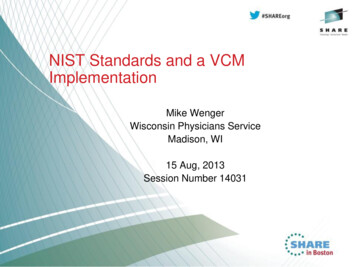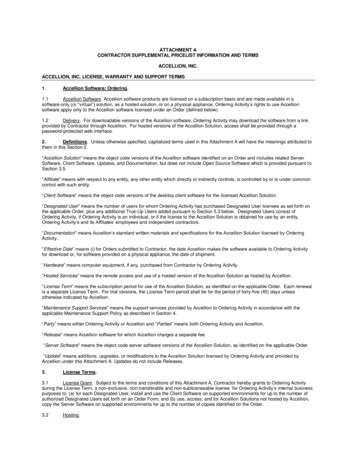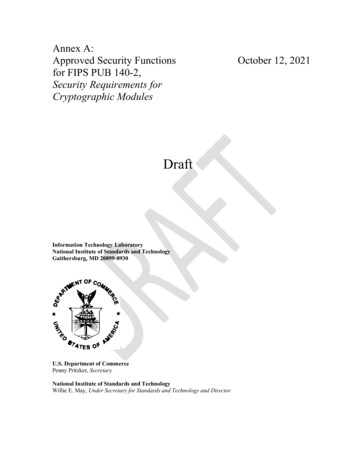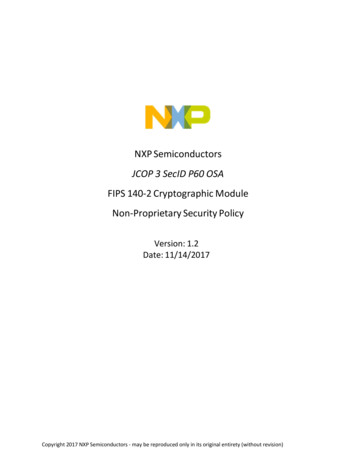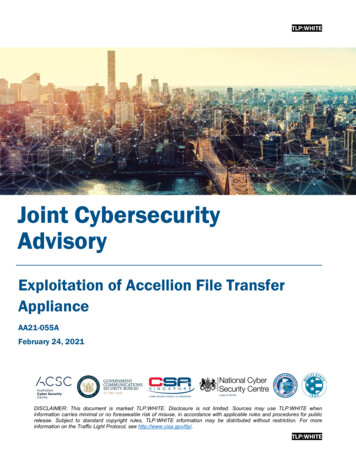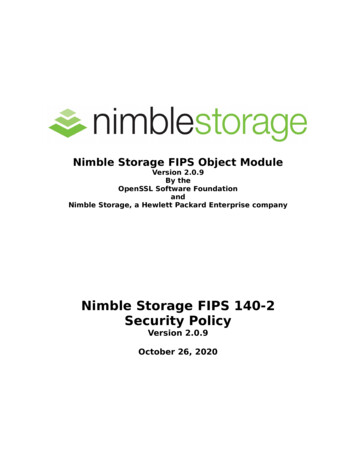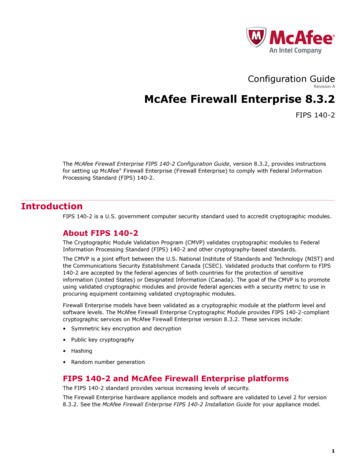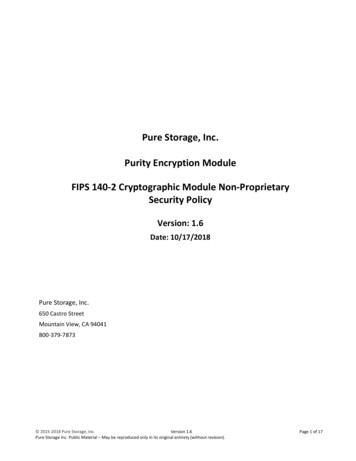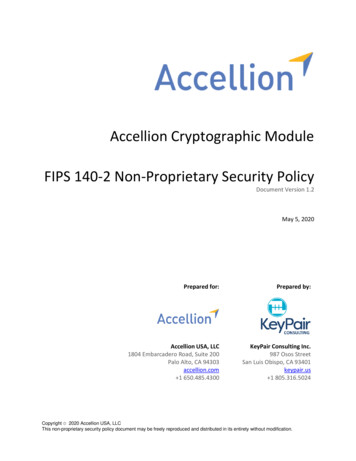
Transcription
Accellion Cryptographic ModuleFIPS 140-2 Non-Proprietary Security PolicyDocument Version 1.2May 5, 2020Prepared for:Prepared by:Accellion USA, LLC1804 Embarcadero Road, Suite 200Palo Alto, CA 94303accellion.com 1 650.485.4300KeyPair Consulting Inc.987 Osos StreetSan Luis Obispo, CA 93401keypair.us 1 805.316.5024Copyright 2020 Accellion USA, LLCThis non-proprietary security policy document may be freely reproduced and distributed in its entirety without modification.
FIPS 140-2 Security PolicyAccellion Cryptographic ModuleReferencesReferenceFull Specification Name[ANS X9.31]Digital Signatures Using Reversible Public Key Cryptography for the Financial ServicesIndustry (rDSA)[FIPS 140-2]Security Requirements for Cryptographic Modules, May 25, 2001[FIPS 180-4]Secure Hash Standard (SHS)[FIPS 186-2]Digital Signature Standard (DSS) [withdrawn][FIPS 186-4]Digital Signature Standard (DSS)[FIPS 197]Advanced Encryption Standard (AES)[FIPS 198-1]The Keyed-Hash Message Authentication Code (HMAC)[IG]Implementation Guidance for FIPS 140-2 and the Cryptographic Module ValidationProgram[SP 800-38A]Recommendation for Block Cipher Modes of Operation: Methods and Techniques[SP 800-38B]Recommendation for Block Cipher Modes of Operation: The CMAC Mode for Authentication[SP 800-38C]Recommendation for Block Cipher Modes of Operation: The CCM Mode for Authenticationand Confidentiality[SP 800-38D]Recommendation for Block Cipher Modes of Operation: Galois/Counter Mode (GCM) andGMAC[SP 800-38E]Recommendation for Block Cipher Modes of Operation: the XTS-AES Mode forConfidentiality on Storage Devices[SP 800-56A]Recommendation for Pair-Wise Key-Establishment Schemes Using Discrete LogarithmCryptography[SP 800-56B R2]Recommendation for Pair-Wise Key-Establishment Schemes Using Integer FactorizationCryptography[SP 800-57 R4]Recommendation for Key Management, Part 1: General[SP 800-67 R2]Recommendation for the Triple Data Encryption Algorithm (TDEA) Block Cipher[SP 800-89]Recommendation for Obtaining Assurances for Digital Signature Applications[SP 800-90A R1]Recommendation for Random Number Generation Using Deterministic Random BitGenerators[SP 800-131A R2]Transitioning the Use of Cryptographic Algorithms and Key Lengths[SP 800-133 R1]Recommendation for Cryptographic Key GenerationPage 2 of 14
FIPS 140-2 Security PolicyAccellion Cryptographic ModuleTable of ContentsReferences.21Introduction .42Ports and Interfaces .53Modes of Operation and Cryptographic Functionality .63.1Critical Security Parameters and Public Keys . 84Roles, Authentication and Services . 105Self-Tests . 126Operational Environment . 137Mitigation of other Attacks . 13Appendix A - Installation and Usage Guidance . 14Page 3 of 14
FIPS 140-2 Security PolicyAccellion Cryptographic Module1 IntroductionThis document is the non-proprietary security policy for the Accellion Cryptographic Module, hereafterreferred to as the Module.The Module is a software library providing a C language application program interface (API) for use byother processes that require cryptographic functionality. The Module is classified by FIPS 140-2 as asoftware module, multi-chip standalone module embodiment. The physical cryptographic boundary is thegeneral-purpose computer on which the module is installed. The logical cryptographic boundary of theModule is the fipscanister object module, a single object module file named fipscanister.o. The Moduleperforms no communications other than with the calling application (the process that invokes the Moduleservices).The current version of the Module is 1.0.The FIPS 140-2 security levels for the Module are as follows:Table 1 - Security Level of Security RequirementsSecurity RequirementSecurity LevelCryptographic Module Specification1Cryptographic Module Ports and Interfaces1Roles, Services, and Authentication2Finite State Model1Physical SecurityNAOperational Environment1Cryptographic Key Management1EMI/EMC1Self-Tests1Design Assurance3Mitigation of Other AttacksPage 4 of 14NA
FIPS 140-2 Security PolicyAccellion Cryptographic ModuleFigure 1 - Module Block Diagram2 Ports and InterfacesThe physical ports of the Module are the same as the computer system on which it is executing. The logicalinterface is a C language application program interface (API).Table 2 - Logical interfacesLogical interface typeDescriptionControl inputAPI entry point and corresponding stack parametersData inputAPI entry point data input stack parametersStatus outputAPI entry point return values and status stack parametersData outputAPI entry point data output stack parametersAs a software module, control of the physical ports is outside module scope; however, when the moduleis performing self-tests, or is in an error state, all output on the logical data output interface is inhibited.The module is single-threaded and in error scenarios returns only an error value (no data output isreturned).Page 5 of 14
FIPS 140-2 Security PolicyAccellion Cryptographic Module3 Modes of Operation and Cryptographic FunctionalityThe Module supports a FIPS 140-2 Approved mode and a non-Approved Mode. Table 3 and Table 4 listthe Approved and non-Approved but Allowed algorithms, respectively. Table 5 lists the non-Approvedalgorithms that shall not be used in the FIPS Approved mode of operation. All services available in theApproved mode of operation are available in the non-Approved mode with the addition of the nonApproved services.Table 3 - FIPS Approved Cryptographic FunctionsFunctionAlgorithmOptionsCert. #Random NumberGeneration;Symmetric KeyGeneration[SP 800-90A R1]DRBG1Hash Based DRBG: All SHA sizesHMAC Based DRBG: All SHA sizesCTR DRBG: AES-128, AES-192, AES-256 (with and withoutderivation function)Prediction resistance supported for all variationsC1318Cryptographic KeyGeneration (CKG)[SP 800-133 R1] CKGEncryption,Decryption andCMAC[SP 800-67] TDES[SP 800-38B] CMACTECB, TCBC, TCFB, TOFB: 3-KeyCMAC generate and verify: 3-KeyC1318[FIPS 197] AES[SP 800-38B] CMAC[SP 800-38C] CCM[SP 800-38D] GCM[SP 800-38E] XTSECB, CBC, OFB, CFB, CTR: 128/192/256CMAC generate and verify: 128/192/256CCM: 128/192/256GCM: 128/192/256XTS: 128/256C1318Message Digests[FIPS 180-4] SHASHA-1, SHA-2 (224, 256, 384, 512)C1318Keyed Hash[FIPS 198] HMACSHA-1, SHA-2 (224, 256, 384, 512)C1318Digital Signature and [FIPS 186-2] RSAAsymmetric KeyGenerationSigGen9.31, SigGenPKCS1.5, SigGenPSS: 4096 with all SHA2 sizesSigVer9.31, SigVerPKCS1.5, SigVerPSS: 1024/1536/2048/3072/4096 with all SHA sizesC1318[FIPS 186-4] RSAKeyGen: 2048/3072SigGen9.31, SigGenPKCS1.5, SigGenPSS: 2048/3072 with allSHA2 sizesC1318[FIPS 186-4] DSAKeyPairGen: 2048/3072PQGGen, SigGen: 2048/3072 with all SHA-2 sizesPQGVer, SigVer: 1024/2048/3072 with all SHA sizesC1318[FIPS 186-4] ECDSAPKG: P-224, P-256, P-384, P-521, K-224, K-256, K-384, K521, B-224, B-256, B-384, B-521; ExtraRandomBits,TestingCandidatesPKV: All NIST defined B, K and P curvesSigGen: P-224, P-256, P-384, P-521, K-224, K-256, K-384, K521, B-224, B-256, B-384, B-521; all SHA2 sizesSigVer: All NIST defined B, K and P curves; all SHA sizesC1318[SP 800-56A](§5.7.1.2)All NIST defined B, K and P curves except sizes 163 and 192C1318ECC CDH (KAS)(CVL)Vendoraffirmed1For all DRBGs the "supported security strengths" is just the highest supported security strength per [SP 800-90AR1] and [SP 800-57 R4].Page 6 of 14
FIPS 140-2 Security PolicyAccellion Cryptographic ModuleThe Module supports the following non-Approved but allowed functions:Table 4 - Non-FIPS Approved but Allowed Cryptographic FunctionsCategoryAlgorithm DescriptionKey AgreementDHKey agreement is a service provided by the module to establish session keys forsecure communication with another module using the Diffie-Hellman (DH)algorithm.Key AgreementEC DHKey agreement is a service provided by the module to establish session keys forsecure communication with another module using the EC Diffie-Hellman (EC DH)algorithm.Key Encryption,DecryptionRSARSA may be used to perform key establishment with another module by securelyexchanging symmetric encryption keys with another module.Entropy sourceNDRNGUsed only to seed the Approved DRBGThe module supports the following non-Approved but allowed algorithms: RSA (key wrapping; key establishment methodology provides between 112 and 256 bits ofencryption strength; non-compliant less than 112 bits of encryption strength)Diffie-Hellman (key agreement; key establishment methodology provides between 112 and 256bits of encryption strength; non-compliant less than 112 bits of encryption strength)EC Diffie-Hellman (CVL Cert. #C1318, key agreement; key establishment methodology providesbetween 112 and 256 bits of encryption strength)The Module implements the following services which are non-Approved per the [SP 800-131A R2]transition:Table 5 - FIPS Non-Approved Cryptographic FunctionsFunctionAlgorithmDigital Signature[FIPS 186-2] RSAand Asymmetric KeyGeneration[FIPS 186-2] DSAECC CDH (CVL)OptionsGenKey9.31, SigGen9.31, SigGenPKCS1.5, SigGenPSS (1024/1536with all SHA sizes, 2048/3072/4096 with SHA-1)PQG Gen, Key Pair Gen, Sig Gen (1024 with all SHA sizes, 2048/3072with SHA-1)[FIPS 186-4] DSAPQGGen, KeyPairGen, SigGen: 1024 with all SHA sizes; 2048/3072with SHA-1[FIPS 186-2] ECDSAPKG: P-192, K-163, B-163SigGen: P-192, P-224, P-256, P-384, P-521, K-163, K-233, K-283, K409, K-571, B-163, B-233, B-283, B-409, B-571[FIPS 186-4] ECDSAPKG: P-192, K-163, B-163SigGen: P-192, K-163, B-163 with all SHA sizes; P-224, P-256, P-384,P-521, K-233, K-283, K-409, K-571, B-233, B-283, B-409, B-571 withSHA-1[SP 800-56A](§5.7.1.2)P-192, K-163, B-163These algorithms shall not be used when operating in the FIPS Approved mode of operation. Use of thenon-conformant algorithms listed in Table 5 will place the module in a non-approved mode of operation.Page 7 of 14
FIPS 140-2 Security PolicyAccellion Cryptographic Module3.1 Critical Security Parameters and Public KeysAll CSPs used by the Module are described in this section. All access to these CSPs by Module services isdescribed in Section 4. The CSP names are generic, corresponding to API parameter data structures.Table 6 - Critical Security ParametersCSP NameDescriptionRSA SGKRSA (2048 to 15360 bits) signature generation keyRSA KDKRSA (1024 to 16384 bits) key decryption (private key transport) keyDSA SGK[FIPS 186-4] DSA (2048/3072) signature generation keyDH PrivateDiffie-Hellman 2048 private key agreement keyECDSA SGKECDSA (All NIST defined B, K, and P curves except sizes 163 and 192) signature generationkeyEC DH PrivateEC DH (All NIST defined B, K, and P curves except sizes 163 and 192) private key agreementkeyAES EDKAES (128/192/256) encrypt / decrypt keyAES CMACAES (128/192/256) CMAC generate / verify keyAES GCMAES (128/192/256) encrypt / decrypt / generate / verify keyAES XTSAES (256/512) XTS encrypt / decrypt keyTriple-DES EDKTriple-DES (3-Key) encrypt / decrypt keyTriple-DES CMACTriple-DES (3-Key) CMAC generate / verify keyHMAC KeyKeyed hash key (160/224/256/384/512)Hash DRBG CSPsV (440/888 bits) and C (440/888 bits), entropy input (length dependent on security strength)HMAC DRBG CSPs V (160/224/256/384/512 bits) and Key (160/224/256/384/512 bits), entropy input (lengthdependent on security strength)CTR DRBG CSPsV (128 bits) and Key (AES 128/192/256), entropy input (length dependent on securitystrength)CO-AD-DigestPre-calculated HMAC-SHA-1 digest used for Crypto Officer role authenticationUser-AD-DigestPre-calculated HMAC-SHA-1 digest used for User role authenticationAuthentication data is loaded into the module during the module build process, performed by anauthorized operator (Crypto Officer), and otherwise cannot be accessed.The module does not output intermediate key generation values.Table 7 - Public KeysPublic Key NameDescriptionRSA SVKRSA (1024 to 16384 bits) signature verification public keyRSA KEKRSA (2048 to 16384 bits) key encryption (public key transport) keyDSA SVK[FIPS 186-4] DSA (2048/3072) signature verification keyECDSA SVKECDSA (All NIST defined B, K and P curves) signature verification keyDH PublicDiffie-Hellman public key agreement keyEC DH PublicEC DH (All NIST defined B, K and P curves) public key agreement key.Page 8 of 14
FIPS 140-2 Security PolicyAccellion Cryptographic ModuleFor all CSPs and Public Keys:Storage: RAM, associated to entities by memory location. The Module stores DRBG state values for thelifetime of the DRBG instance. The module uses CSPs passed in by the calling application on the stack. TheModule does not store any CSP persistently (beyond the lifetime of an API call), with the exception ofDRBG state values used for the Module’s default key generation service.Generation: The Module implements SP 800-90A compliant DRBG services for creation of symmetric keys,and for generation of DSA, elliptic curve, and RSA keys as shown in Table 3. The calling application isresponsible for storage of generated keys returned by the Module. For operation in the Approved mode,Module users (the calling applications) shall use entropy sources that contain at least 112 bits of entropy.To ensure full DRBG strength, the entropy sources must meet or exceed the security strengths shown inthe table below:Table 8 - DRBG Entropy RequirementsDRBG TypeHash DRBG or HMAC DRBGCTR DRBGUnderlying AlgorithmMinimum Seed 12256AES-128128AES-192192AES-256256Entry: All CSPs enter the Module’s logical boundary in plaintext as API parameters, associated by memorylocation; however, none cross the physical boundary.Output: The Module does not output CSPs, other than as explicit results of key generation services;however, none cross the physical boundary.Destruction: Zeroization of sensitive data is performed automatically by API function calls fortemporarily stored CSPs. In addition, the module provides functions to explicitly destroy CSPs related torandom number generation services. The calling application is responsible for parameters passed intoand out of the module.Private and secret keys as well as seeds and entropy input are provided to the Module by the callingapplication, and are destroyed when released by the appropriate API function calls. Keys residing ininternally allocated data structures (during the lifetime of an API call) can only be accessed using theModule defined API. The operating system protects memory and process space from unauthorized access.Only the calling application that creates or imports keys can use or export such keys. All API functions areexecuted by the invoking calling application in a non-overlapping sequence such that no two API functionswill execute concurrently. An authorized application as user (Crypto-Officer and User) has access to all keydata generated during the operation of the Module.Use: In the case of AES-GCM, the IV generation method is user selectable and the value can be computedin more than one manner.Page 9 of 14
FIPS 140-2 Security PolicyAccellion Cryptographic ModuleFollowing RFC 5288 for TLS, the module ensures that it's strictly increasing and thus cannot repeat. Whenthe IV exhausts the maximum number of possible values for a given session key, the first party, client orserver, to encounter this condition may either trigger a handshake to establish a new encryption key inaccordance with RFC 5246, or fail. In either case, the module prevents and IV duplication and thus enforcesthe security property. The Module’s IV is generated internally by the Module’s Approved DRBG. The DRBGseed is generated inside the Module’s physical boundary. The IV is 96 bits in length per NIST SP 800-38D,Section 8.2.2 and FIPS 140-2 [IG] A.5 scenario 2.The selection of the IV construction method is the responsibility of the user of this Module. In theapproved mode, users of the Module must not utilize GCM with an externally generated IV.In the event that Module power is lost and restored, the calling application must ensure that any AESGCM keys used for encryption or decryption are re-distributed.The calling application shall ensure that the same Triple-DES key is not used to encrypt more than 216 64bit blocks of data.4 Roles, Authentication and ServicesThe Module implements the required User and Crypto Officer roles and requires authentication for thoseroles. Only one role may be active at a time, and the Module does not allow concurrent operators. TheUser or Crypto Officer role is assumed by passing the appropriate password to theFIPS module mode set() function. The password values may be specified at build time and must havea minimum length of 16 characters. Any attempt to authenticate with an invalid password will result in animmediate and permanent failure condition rendering the Module unable to enter the FIPS mode ofoperation, even with subsequent use of a correct password.Authentication data is loaded into the Module during the Module build process, performed by the CryptoOfficer, and otherwise cannot be accessed.Since the minimum password length is 16 characters, the probability of a random successfulauthentication attempt in one try is a maximum of 1/25616, or less than 1/1038. The Module permanentlydisables further authentication attempts after a single failure, so this probability is independent of time.Both roles have access to all of the services provided by the Module. User Role (User): Loading the Module and calling any of the API functions. Crypto Officer Role (CO): Installation of the Module on the host computer system and calling ofany API functions.All services implemented by the Module are listed below, along with a description of service CSP access.The access types are determined as follows:- Generate (G): Generate the CSP using an approved Random Bit Generator- Read (R): Export the CSP- Write (W): Enter/establish and store a CSP- Destroy (D): Overwrite the CSP- Execute (E): Employ the CSP- None: No access to CSPsPage 10 of 14
FIPS 140-2 Security PolicyAccellion Cryptographic ModuleTable 9 - Services and CSP er, COModule initialization. Does not access CSPs.CO-AD-Digest, User-AD-DigestESelf-testUser, COPerform self-tests (FIPS selftest).NoneShow statusUser, CONoneZeroizeUser, COFunctions that provide module status information: Version (as unsigned long or const char *) FIPS Mode (Boolean)Functions that destroy CSPs: fips drbg uninstantiateDRBG CSPs (Hash DRBG CSPs, HMAC DRBG CSPs, CTR DRBG CSPs)All other services automatically overwrite CSPs stored in allocatedmemory. Stack cleanup is the responsibility of the calling application.RandomnumbergenerationUser, COEAsymmetrickey generationUser, COUsed for random number and symmetric key generation Seed or reseed a DRBG instance Determine security strength of a DRBG instance Obtain random dataDRBG CSPs (Hash DRBG CSPs, HMAC DRBG CSPs, CTR DRBG CSPs)Used to generate DSA, ECDSA and RSA keys:RSA SGK, RSA SVK; DSA SGK, DSA SVK; ECDSA SGK, ECDSA SVKSymmetricencrypt/decryptUser, COUsed to encrypt or decrypt data.AES EDK, Triple-DES EDK, AES GCM, AES XTS (passed in by the callingprocess)ESymmetricdigestUser, COUsed to generate or verify data integrity with CMAC.AES CMAC, Triple-DES CMAC (passed in by the calling process)EMessage digestUser, COUsed to generate a SHA-1 or SHA-2 message digest.NoneKeyed HashUser, COUsed to generate or verify data integrity with HMAC.HMAC Key (passed in by the calling process)EKey transport2User, COUsed to encrypt or decrypt a key value on behalf of the calling process(does not establish keys into the module).RSA KDK, RSA KEK (passed in by the calling process)EKey agreementUser, COUsed to perform key agreement primitives on behalf of the callingprocess (does not establish keys into the module).DH/EC DH Private, DH/EC DH Public (passed in by the calling process)EDigitalsignatureUser, COUsed to generate or verify RSA, DSA or ECDSA digital signatures.RSA SGK, RSA SVK; DSA SGK, DSA SVK; ECDSA SGK, ECDSA SVK (passed inby the calling process)EUtilityUser, COMiscellaneous helper functions.NoneDG2 "Key transport" can refer to a) moving keys in and out of the module or b) the use of keys by an external application.The latter definition is the one that applies to the Module.Page 11 of 14
FIPS 140-2 Security PolicyAccellion Cryptographic Module5 Self-TestsThe Module performs the self-tests listed below on invocation of Initialize or Self-test.Table 10 - Power-On Self-Tests (KAT Known answer test; PCT Pairwise consistency test)AlgorithmTypeTest AttributesSoftware integrityKATHMAC-SHA1HMACKATOne KAT per SHA-1, SHA-224, SHA-256, SHA-384 and SHA-512Per [IG] 9.3, this testing covers SHA POST requirements.AESKATSeparate encrypt and decrypt, ECB mode, 128-bit key lengthAES CCMKATSeparate encrypt and decrypt, 192-bit key lengthAES GCMKATSeparate encrypt and decrypt, 256-bit key lengthXTS-AESKAT128, 256-bit key sizes to support either the 256-bit key size (for XTS-AES-128) orthe 512-bit key size (for XTS-AES-256)AES CMACKATGenerate and verify CBC mode, 128, 192, 256-bit key lengthsTDESKATSeparate encrypt and decrypt, ECB mode, 3-KeyTDES CMACKATCMAC generate and verify, CBC mode, 3-KeyRSAKATSign and verify using 2048-bit key, SHA-256, PKCS#1DSAPCTSign and verify using 2048-bit key, SHA-384DRBGKATCTR DRBG: AES, 256 bits with and without derivation functionHASH DRBG: SHA-256HMAC DRBG: SHA-256ECDSAPCTKey gen, sign, verify using P-224, K-233 and SHA-512ECC CDHKATShared secret calculation per SP 800-56A §5.7.1.2, [IG] 9.6The Module is installed using one of the set of instructions in Appendix A, as appropriate for the targetsystem. The HMAC-SHA-1 of the Module distribution file as tested by the CMT Laboratory and listed inAppendix A is verified during installation of the Module file as described in Appendix A.Per [IG] 9.10, the Module implements a default entry point and automatically runs the FIPS self-tests uponstartup.The module has a function called FIPS module mode set() within the init code that is automaticallyset to enable “FIPS Mode” by default. When the Module is initialized, it will always run its power-on selftests, meeting the [IG] 9.10 requirement.The module also has a Boolean check value to verify whether the module has run its power-on self-testsupon subsequent instantiations. If the module is determined to have already run its power-on self-tests,future instantiations will only run the power-up integrity test and not the full set of POSTs. If power is lostto the module, the Boolean check value “1” is zeroized and the module will run its power-up self-testsagain to verify the correctness of the module operation. Upon successful completion of the POSTs, theBoolean check value is restored. This is consistent with the requirement described in [IG] 9.11.Page 12 of 14
FIPS 140-2 Security PolicyAccellion Cryptographic ModuleThe Module also implements the following conditional tests:Table 11 - Conditional TestsAlgorithmTestDRBGTested as required by [SP 800-90A R1] Section 11DRBGFIPS 140-2 continuous test for stuck faultNDRNGFIPS 140-2 continuous test for NDRNGDSAPairwise consistency test on each generation of a key pairECDSAPairwise consistency test on each generation of a key pairRSAPairwise consistency test on each generation of a key pairIn the event of a DRBG self-test failure, the calling application must uninstantiate and re-instantiate theDRBG per the requirements of [SP 800-90A R1]; this is not something the Module can do itself.Pairwise consistency tests are performed for both possible modes of use, e.g. Sign/Verify andEncrypt/Decrypt.6 Operational EnvironmentThe tested operating systems segregate user processes into separate process spaces. Each process spaceis logically separated from all other processes by the operating system software and hardware. TheModule functions entirely within the process space of the calling application, and implicitly satisfies theFIPS 140-2 requirement for a single user mode of operation.The module was tested in the following configurations.Table 12 - Tested Configurations#Operating S 6Intel Xeon E5-2609PAAHPE ProLiant DL60 Gen92CentOS 6Intel Xeon E5-2609NoneHPE ProLiant DL60 Gen93CentOS 7Intel Xeon E5-2609PAAHPE ProLiant DL60 Gen94CentOS 7Intel Xeon E5-2609NoneHPE ProLiant DL60 Gen9As described in [IG] 1.21, Processor Algorithm Acceleration (PAA) describes mathematical constructs andnot the complete cryptographic algorithm (as defined in the NIST standards). Examples of PAA supportedby the Module include AES-NI and NEON.7 Mitigation of other AttacksThe module is not designed to mitigate against attacks which are outside of the scope of FIPS 140-2.Page 13 of 14
FIPS 140-2 Security PolicyAccellion Cryptographic ModuleAppendix A - Installation and Usage GuidanceDuring the manufacturing process, Accellion executes the build and installation instructions for theModule.The Module is pre-installed and configured on supported Accellion solutions. FIPS mode is enabled bydefault. There are no additional installation, configuration, or usage instructions for operators intendingto use the Accellion Cryptographic Module.Page 14 of 14
FIPS 140-2 Security Policy Accellion Cryptographic Module Page 4 of 14 1 Introduction This document is the non-proprietary security policy for the Accellion Cryptographic Module, hereafter referred to as the Module. The Module is a software library providing a C language application program interface (API) for use by
